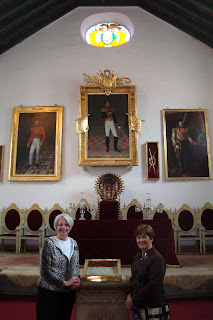 |
| This is from that tall tower in the middle of the castle. There is a military base on the other side of the river. |
 |
| Looking down from the tower to "Big Ben" in front of the chapel. |
 |
| These are the stairs going down from the tower. They were really steep and "skinny". |
 |
| Because the wife didn't have any children, she collected dolls. This is the house on the grounds where she would keep her dolls and play house. |
 |
| This is how you buy cakes at the market. There were lots of flies, but the cakes looked pretty good. |
 |
| In the park. We decided to each take a picture on the lion. |









































